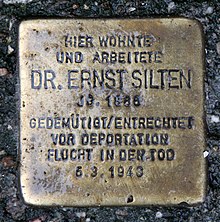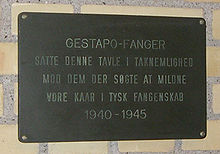Helmut Pfeiffer (lawyer)
Helmut Roland Heinrich Pfeiffer (born November 2, 1907 in Eiringhausen near Plettenberg , Westphalia, † April 17, 1945 in Copenhagen ) was a German lawyer and SS officer who rescued people persecuted by the Nazi regime .
Professional background
Pfeiffer was the son of the commercial foreman Heinrich Pfeiffer and his wife Selma, née Breddermann. After graduating from high school in Altena , he studied law and political science in Cologne . His legal traineeship exam took place in 1931 and he completed his assessor exam in 1935. From 1932 he was managing director of the Gaurechtsamt Westfalen-Süd of the NSDAP , from 1933 additionally legal advisor to the labor service Gau 20B. From 1934 he was the organizational administrator of the Nazi legal guardian association , then head of the main branch in the Reich leadership of the NSDAP in the Reich Legal Office. Since 1934 he was also a volunteer in the organization of the commercial economy, also as chairman of the arbitration board of the business groups metal goods industry and iron, steel and sheet metal industry.
From November 1, 1939, he was the head of the main economics department at the agent of the General Government , Reichsamtsleiter Wilhelm Heuber . After the International Chamber of Law was founded in 1941, he acted as its (first) general secretary. The International Chamber of Law was founded by Hans Frank and acted after a brief 'sublease' in the house of the National Socialist Legal Guardian Association (Berlin, Tiergartenstrasse 20/21) from the address Berlin, Unter den Linden 27. From November 1941, Pfeiffer was SS leader in the staff of the SS main office and from November 1942 SS leader in the Reich Security Main Office (RSHA). In the winter of 1944 he was SS-Hauptsturmführer in RSHA Amt VI-III-Kult.
In addition to all these functions, he ran a law firm, which provided the unsuspicious basis for his relief efforts.
Political career
Pfeiffer first came into contact with National Socialism in Cologne in 1927 . From 1929 to 1931 he worked as legal advisor to the local group leader of the NSDAP during the holidays . On February 1, 1932 he joined the NSDAP ( membership number 894.201). He was possibly a member of the SA from 1933 to 1934. On November 9, 1938, on the recommendation of SS-Obergruppenführer Friedrich-Wilhelm Krüger, he was accepted into the SS (membership number 310.479) with the rank of SS-Hauptsturmführer.
Pfeiffer was a student and later a close collaborator of the constitutional lawyer and legal theorist Carl Schmitt , with whom he also maintained private contact. Pfeiffer also had a close relationship with the later Governor General of occupied Poland, Hans Frank , initially in the Legal Guardian Association, then during his activities in the General Government and finally with the International Chamber of Justice.
In the early summer of 1943, Pfeiffer was involved in the forwarding of a separate peace offer from Stalin : "I therefore took my heart and informed him on behalf of a Berlin friend that Bormann asked for a final discussion of my intended later publication of 'Hitler's Table Talks'' of the Secretary General of the International Chamber of Law, Dr. Helmut Pfeiffer, from a 'separate peace offer from Stalin' that has just been made in Stockholm. "
Rescue operations
In autumn 1942 the Jewish pharmacist Ernst Silten from Berlin learned “that (Pfeiffer) could prevent my emigration if I was asked to solve economic problems.” His long-standing business partner, the Lübeck industrialist Heinrich Dräger , commissioned the lawyer to make this request. This did not happen, however, because Ernst Silten committed suicide in March 1943 on the occasion of a Gestapo mission.
Ernst Silten's son Fritz Silten had emigrated from Germany with his wife Ilse, his daughter Gabriele and his mother in 1938 and had settled in Amsterdam . After the occupation of the Netherlands by the Wehrmacht , they were refused to emigrate to Argentina and in June 1943 the family was deported to Theresienstadt via the Westerbork transit camp in January 1944 . Pfeiffer tried, through his contacts, first to prevent the transport to Westerbork and then the further shipment to Theresienstadt, to delay it or at least to obtain a temporary leave of absence. Thanks to his and Dräger's efforts, Fritz, Ilse and Gabriele Silten survived the Nazi regime.
Pfeiffer continued to stand up for the lawyer Philipp Kozower, a board member of the Jewish Community in Berlin , who was brought to Theresienstadt with his wife and three small children in January 1943. However, his rescue attempts came too late because the family was deported to Auschwitz in autumn 1944 and murdered.
Together with the Danish lawyer Erik Reitzel Nielsen , Pfeiffer tried to get the Danish textile merchant Willy Levysohn (1889–1944) released from the Theresienstadt concentration camp . Unlike most of the Danish Jews and his wife and two children, Levysohn did not manage to escape to Sweden on September 30, 1943 because he had been arrested by the Germans a month earlier. On October 14, 1943, he was deported to Theresienstadt on Transport XXV / 3, where he died of 'pneumonia' in March 1944.
Further credible incidents are known from testimonies, but these have not yet been proven: In 1942 or 1943 Pfeiffer filed a lawsuit against Gestapo officials in Poland because they had appropriated the assets of a so-called “non-Aryan”. Pfeiffer was reported by the Gestapo for this complaint.
Pfeiffer also was involved in the 2000 Danish police officers arrested in September 1944 by the German occupying forces and the Neuengamme concentration camp to Buchenwald concentration camp were brought. It is not known how Pfeiffer's rescue attempts looked in detail, but his intervention is referred to several times in the minutes of the parliamentary commission of inquiry of October 25, 1950.
There is also the eyewitness report by Mirjana Tomljenovic-Markovic, which has not yet been clarified on the basis of the data: His last rescue operation concerned four Poles who were not known by name, including three Jewish ones who Pfeiffer had previously smuggled into Denmark. He took her with him when he tried to escape to Sweden in April 1945. They were also taken to the Gestapo headquarters in Copenhagen and then further to the West Prison, where they were to be shot on April 27, 1945. Due to the beginning of the dissolution of the Third Reich , these executions no longer took place.
Due to the incomplete evidence, Helmut Pfeiffer has not yet been included in the relevant databases and memorials.
Military background
Because of a heart defect he was released from duty, later indispensable (uk) (Wehrpass Berlin VIII 07/179/14/4 of April 21, 1939 Ers. Res. Bd. Daily II b.). Due to political unreliability, his position in the uk was canceled around the beginning of 1944, but he was able to postpone his draft. He evaded being drafted to SS Panzerjäger Training and Replacement Department 1 (Rastenburg / East Prussia) on January 5, 1945 by fleeing to Denmark .
End of life
To protect him from the Gestapo , friends took him to a Copenhagen hospital for a fictitious appendectomy. The hospital stay was extended by febrile injections. On the night of April 10th to 11th, 1945 he tried to escape to Sweden by boat, but in vain: The ship was seized by the waterway police or the naval coast police and Pfeiffer was brought to the Gestapo headquarters (Dagmarhaus). He was then transferred to the western prison. On April 17, 1945, he was found strangled in his cell.
Pfeiffer was finally buried in Copenhagen's Vestre Kirkegård (E / 1/3071 1314) in the German war cemetery in Copenhagen West (Vestre Kirkegård) . His grave is cared for by the Volksbund Deutsche Kriegsgräberfürsorge .
"While the lawyer Pfeiffer, who worked closely with Dräger, was murdered by the Gestapo on April 17, 1945 in Copenhagen because of these activities for Jews, the entrepreneur was able to hide his commitment until the end of the war."
Awards
- Ehrenwinkel the old fighters
- Service award of the NSDAP in bronze
- War Merit Cross, 2nd class
- Knight's Cross of the Kgl. Danish Order of Dannebrog (1940-1945)
Writings by Helmut Pfeiffer
- The insurance broker . Inaugural dissertation, Law Faculty of the University of Cologne, Würzburg 1932.
- Legal education . In: Unser Wille und Weg / Heft 5, May 1939, page 113. Monthly sheets of the Reich Propaganda Office of the NSDAP. The party official propaganda magazine of the NSDAP. Editor: Dr. J. Goebbels.
- Conference report of the international legal meeting in Berlin from April 3rd to 5th, 1941 on the occasion of the establishment of the international chamber of law . Editor: Helmut Pfeiffer, Deutscher Rechtsverlag, 1941.
- The Government General and its economy . Edited by State Secretary Dr. Josef Bühler, Head of the Office of the Governor General, Reichsamtsleiter Dr. Wilhelm Heuber, Plenipotentiary of the Governor General in Berlin. Edited by lawyer Dr. Helmut Pfeiffer, head of the economic department of the Plenipotentiary of the Governor General in Berlin. German publishing house for politics and economics, Economic System Department, Berlin-Halensee, loose-leaf collection: 1940, additions 1941.
- The tasks of the International Chamber of Law . In: Arch. F. Copyright, film and theater law 15, 1, 2–5 (1942) Archive of the International Chamber of Law 1942 / with a foreword by Dr. Without worries; edited and compiled by Helmut Pfeiffer. Berlin. Jamrowski. 1943, 174 pp.
- Organization report . In: Minutes of the working session of the International Chamber of Law, High Tatras, June 1943, copied typing
Literature and Sources
- Bernhard Lorentz: Industrial elite and economic policy 1928 - 1950. Heinrich Dräger and the Drägerwerk . Schöningh, Paderborn 2001, ISBN 3-506-75255-3 (Zugl .: Dissertation Humboldt University Berlin 1998/99)
- R. Gabriele Silten: Between Two Worlds . Fithian Press, 1995, ISBN 1-56474-126-5 , pp. 76ff.
- Süderländer Tageblatt from February 15, 2008.
- Beretning til Folketinget afgivet af den af tinget under 25 October 1950 Nedsatte Commission i henhold til Grundlovens § 45, 153 ff.
- Files from the Rasse- und Siedlungs-Hauptamt-SS from November 1944 / Bundesarchiv Berlin
- Susanne Krejsa: Searching for clues . The Nazi lawyer and rescuer Helmut Pfeiffer . Past Publishing , Berlin 2011, ISBN 3-86408-003-7 .
Web links
Individual evidence
- ↑ Files from the Rasse- und Siedlungs-Hauptamt-SS from November 1944 / Bundesarchiv Berlin
- ^ H. Picker: "Hitler's table talks in the Führer Headquarters", Seewald Verlag, 1976, ISBN 3-442-11234-6 , p. 32f.
- ↑ Erik Reitzel Nielsen, draft of a retrial motion against his conviction (Danish), December 12, 1952 (Rigsarkivet, Copenhagen)
- ↑ "Beretning til Folketinget afgivet af den af tinget under 25 October 1950 Nedsatte Commission i henhold til Grundlovens § 45", 153 ff.
- ^ Death certificate in Rigsarkivet, Copenhagen
- ^ B. Lorentz: Industrial elite and economic policy 1928 - 1950. Heinrich Dräger and the Drägerwerk . Schöningh, Paderborn 2001, ISBN 3-506-75255-3 (Zugl .: Dissertation Humboldt University Berlin 1998/99), p. 232
- ^ Information from Asbjørn Thyssen Hansen, archivist of the chapter of the order, dated August 5, 2009
| personal data | |
|---|---|
| SURNAME | Pfeiffer, Helmut |
| ALTERNATIVE NAMES | Pfeiffer, Helmut Roland Heinrich (full name) |
| BRIEF DESCRIPTION | German lawyer and SS officer |
| DATE OF BIRTH | November 2, 1907 |
| PLACE OF BIRTH | Eiringhausen , Westphalia Province , Kingdom of Prussia , German Empire |
| DATE OF DEATH | April 17, 1945 |
| Place of death | Copenhagen , Denmark |




